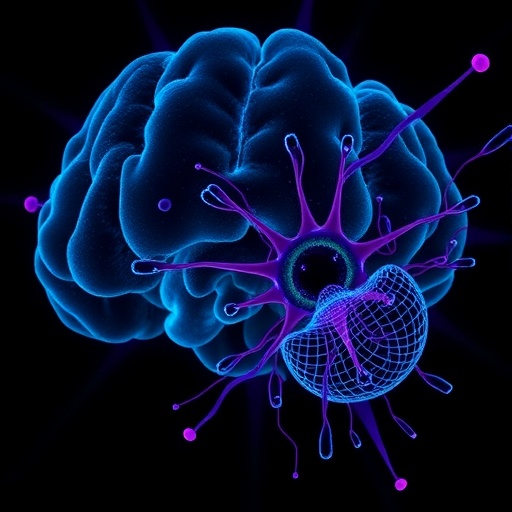
In the intricate microenvironment of the central nervous system (CNS), microglia have long been regarded as the paramount guardians of neural sanctity. These resident innate immune cells comprise roughly 10% of the CNS parenchyma and tirelessly scan the milieu, acting as vigilant sentinels that preserve homeostasis. Their roles span beyond mere surveillance, extending to debris clearance, modulation of inflammation, and orchestration of repair mechanisms when the neural landscape is disturbed. However, recent groundbreaking research has illuminated a critical limitation: under the duress of severe acute or chronic neurological conditions, including Alzheimer’s disease, microglia may falter, necessitating reinforcements from an unexpected ally — monocyte-derived macrophages (MDMs).
This paradigm-shifting discovery, articulated in a seminal paper by Abellanas and colleagues published in Nature Neuroscience, delves into the nuanced interplay between microglia and MDMs within the Alzheimer’s disease brain. The researchers present compelling evidence that microglia, when overwhelmed by continuous hostile stimuli inherent to neurodegeneration, undergo functional exhaustion or senescence. This compromised state diminishes their capacity to effectively contain and mitigate neuronal damage. It is precisely in this critical window that MDMs are recruited, assuming crucial reparative duties that microglia can no longer fulfill.
The distinction between microglia and MDMs, although subtle in morphology, is profound in function and origin. Microglia arise from embryonic yolk sac progenitors and are long-lived residents of the CNS, while MDMs emerge from circulating monocytes that infiltrate the brain under specific pathological circumstances. This infiltration is tightly regulated, underscoring the delicate balance the CNS maintains to prevent unwarranted immune activation that could exacerbate neuronal injury. The study encapsulates the conditions prompting MDM recruitment, focusing on the inflammatory cues and chemotactic signals that breach the blood-brain barrier in Alzheimer’s contexts.
Importantly, Abellanas et al. expand our understanding of cellular “cross-talk” within the CNS immune milieu. Their findings suggest intricate bidirectional communication pathways whereby MDMs and microglia engage in regulatory dialogues. This interaction can influence the phenotype, activation state, and functional capacity of both cell types. Intriguingly, MDMs often adopt a reparative, pro-resolving profile that complements or even surpasses microglial efforts, leading to enhanced clearance of amyloid-beta plaques and attenuation of neuroinflammation.
However, the recruitment of MDMs to the neurodegenerative brain is frequently insufficient, a critical bottleneck impeding their potential therapeutic utility. The research highlights a constellation of factors that limit MDM homing, including the restrictive nature of the blood-brain barrier, the inflammatory microenvironment, and the presence of inhibitory signals from exhausted microglia or other CNS-resident cells. These barriers culminate in a scenario where MDMs arrive “too little, too late,” unable to effectively counterbalance microglial dysfunction.
The implications of these insights are far-reaching. Therapeutic strategies that aim to modulate or augment MDM infiltration and activity hold promising potential for altering the course of Alzheimer’s disease and potentially other neurodegenerative disorders. Abellanas and colleagues advocate for nuanced approaches that harness the beneficial capacities of MDMs while avoiding deleterious chronic inflammation or autoimmunity. Such interventions would necessitate precise control over timing, dosing, and localization within the CNS — a formidable challenge for neuroimmunology.
To this end, burgeoning technologies enabling targeted delivery of therapeutic agents could revolutionize the landscape. Nanoparticle systems, receptor-specific ligands, and engineered monocytes are being explored as innovative conduits to bolster MDM recruitment and function. These approaches aim not just to enhance MDM presence but to direct their phenotypic polarization towards neuroprotective and reparative states. The study’s comprehensive examination of molecular pathways involved in MDM trafficking and signaling presents a valuable blueprint for these future endeavors.
Beyond the context of Alzheimer’s disease, the principles uncovered by this research reverberate across a spectrum of CNS disorders characterized by inflammation and degeneration. From multiple sclerosis to stroke and traumatic brain injury, understanding the limits of microglial capacities and the compensatory roles of MDMs could redefine therapeutic horizons. Moreover, the concept of immune cell exhaustion or senescence within the CNS expands our grasp of neuroimmune aging and its contribution to disease progression.
Abellanas et al. also address the potential pitfalls of excessive or dysregulated MDM activity. While these cells provide essential reparative functions, unchecked infiltration or persistence may exacerbate tissue damage or contribute to chronic inflammatory states. Balancing immune activation with resolution remains a central challenge; hence, developing “immune rheostats” that fine-tune MDM responses is a promising avenue under active investigation.
From a methodological perspective, the study leverages state-of-the-art genetic fate mapping, single-cell transcriptomics, and in vivo imaging to dissect the cellular and molecular tapestry of microglia-MDM interactions. These high-resolution analytical techniques enable unprecedented insights into the heterogeneity, dynamics, and functional specialization of CNS innate immune cells in both health and disease contexts, pushing the frontier of neuroimmunology research.
Furthermore, the article touches upon the evolving understanding of microglial senescence itself, a dynamic state characterized by altered gene expression, impaired phagocytosis, and a pro-inflammatory secretory profile. This senescence contributes not only to diminished defense but paradoxically amplifies neurodegeneration through sustained inflammation — a process that MDMs may help to counteract if adequately recruited.
The recognition that CNS immunity operates as an integrated network, rather than isolated cellular entities, marks a conceptual leap. This holistic view underscores the necessity for multidisciplinary research at the interface of neuroscience, immunology, and molecular biology. Collaborations across these disciplines will be critical for translating these fundamental discoveries into tangible clinical interventions to combat devastating diseases like Alzheimer’s.
In summary, the work of Abellanas and colleagues reframes our understanding of CNS immune resilience by unveiling the “reinforcement” role played by monocyte-derived macrophages when resident microglia reach their functional limits. This discovery not only enhances the mechanistic comprehension of Alzheimer’s disease pathophysiology but also opens compelling therapeutic vistas that harness the innate immune system’s plasticity and reparative potential. As the conversation around neurodegeneration continues to evolve, this research stands as a beacon guiding future efforts to modulate innate immunity for brain health.
The scientific community and clinical researchers alike will watch keenly as subsequent studies build on these findings, exploring ways to safely and effectively manipulate MDM recruitment and function. Such approaches could herald a new era where innate immune cell dynamics are harnessed to halt or possibly reverse the course of Alzheimer’s and other neurological diseases. The intricate dance between microglia and MDMs within the brain’s immune microcosm may thus hold the key to unlocking more effective neurotherapeutics in the years ahead.
Subject of Research: The functional interplay and compensatory roles of monocyte-derived macrophages when microglia become exhausted or senescent in the context of Alzheimer’s disease.
Article Title: Monocyte-derived macrophages act as reinforcements when microglia fall short in Alzheimer’s disease.
Article References:
Abellanas, M.A., Purnapatre, M., Burgaletto, C. et al. Monocyte-derived macrophages act as reinforcements when microglia fall short in Alzheimer’s disease. Nat Neurosci 28, 436–445 (2025). https://doi.org/10.1038/s41593-024-01847-5
Image Credits: AI Generated
DOI: https://doi.org/10.1038/s41593-024-01847-5
Tags: Alzheimer’s disease immune responsecentral nervous system homeostasisfunctional exhaustion of microgliainnate immune cells in CNSinteractions between microglia and macrophagesmacrophage recruitment in neurodegenerationmicroglia and monocyte-derived macrophagesmicroglial senescence in Alzheimer’sneural repair mechanisms in Alzheimer’sneurodegeneration and inflammationpathological roles of immune cells in neurodegenerative diseasesrole of macrophages in brain health



